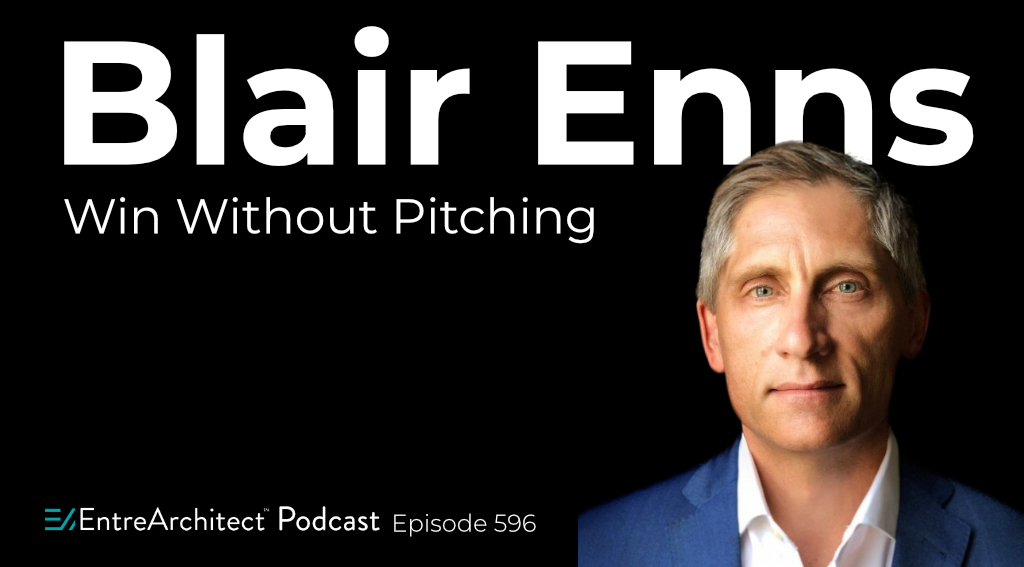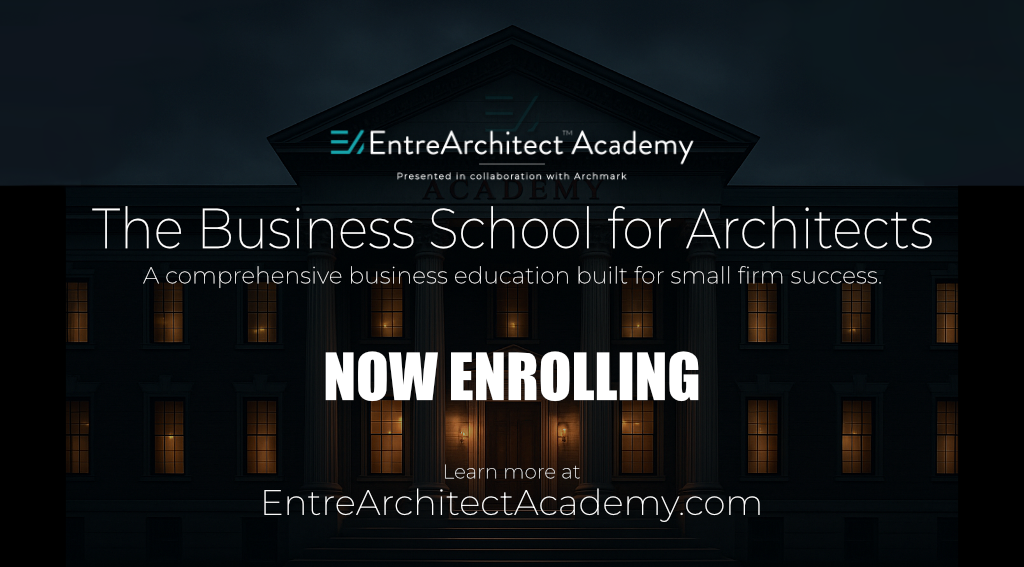
As architects, selling our services effectively can be one of our biggest challenges. While we excel at design and creating beautiful spaces, many of us struggle with the sales process. Most of us went to architecture school to design buildings, not to become salespeople. That’s why I was excited to welcome back Blair Enns to EntreArchitect Podcast to discuss how architects sell services more effectively using the framework from his new book, The Four Conversations: A New Model for Selling Expertise.
How Architects Can Shift from Vendor to Expert
The most profound insight from our conversation was about how architects sell services: you can either position yourself as a vendor or an expert. This foundational choice impacts everything from your pricing power to the quality of your final work.
When architects sell services as vendors, they’re just another option found through a Google search. They compete primarily on price and availability. But when architects position themselves as experts, they transform the entire client relationship dynamic. This positioning isn’t just marketing – it’s about embracing your expertise and letting it guide every client interaction.
Building Expert Authority
To position yourself as an expert, focus on:
- Sharing your unique design philosophy and approach
- Documenting and showcasing successful projects
- Creating valuable content that demonstrates your expertise
- Building a strong presence in your target market
- Developing a clear specialization or niche
The Four Conversations Framework: How Architects Sell Services Successfully
Blair’s framework breaks down how architects sell services into four distinct conversations. This structure brings clarity to what often feels like an uncertain process. While these conversations may not always happen in perfect order, understanding their purpose and structure helps architects navigate client relationships more effectively.
1. The Probative Conversation: Building Your Expert Position
Before architects ever meet potential clients, this crucial “conversation” happens through:
- Strategic positioning in the market
- Clear differentiation from other architects
- Public demonstration of expertise
With AI now influencing how clients find architects (even through ChatGPT recommendations), building a strong digital presence and reputation has become essential for how architects sell services effectively.
Digital Presence Strategies
Modern architects need to consider:
- Professional website with strong portfolio presentation
- Active social media presence (especially visual platforms)
- Regular content creation (blog posts, videos, podcasts)
- Online reviews and testimonials
- Digital PR and media coverage
2. The Qualifying Conversation: Finding the Right Clients
This is where architects determine client fit. The key is being direct about potential misalignments. Instead of trying to make every project work, be willing to say, “I’m concerned about the fit here because…” and then listen to the response.
Essential Qualifying Questions
Consider asking:
- What’s your timeline for this project?
- Have you worked with an architect before?
- What’s your budget range for both design and construction?
- What are your must-haves versus nice-to-haves?
- How do you envision the design process working?
Remember, saying no to the wrong clients makes room for the right ones. In my practice, I’ve learned that red flags during the qualifying conversation almost always lead to challenging projects. Trust your instincts here.
3. The Value Conversation: Understanding Client Success
This conversation is crucial for how architects sell services, especially in residential work. When clients describe their dream home, they’re really describing desired feelings and experiences. Understanding this emotional value is key to selling architectural services effectively.
Uncovering True Value
For residential clients, value often connects to:
- Family gatherings and entertainment spaces
- Daily routines and lifestyle enhancement
- Status and community standing
- Personal achievement and success
- Environmental responsibility and sustainability
- Long-term legacy planning
I’ve found that asking clients to imagine themselves three years after project completion helps uncover these deeper values. Questions like “What makes you happiest about your new space?” reveal the emotional drivers behind their decision to hire an architect.
4. The Closing Conversation: Presenting Options
Rather than offering a single proposal, successful architects sell services by providing three different ways to work together. This transforms the conversation from yes/no into finding the best approach for the client’s needs.
Structuring Your Options
Consider these approaches:
- Basic Service Package: Core architectural services meeting primary project needs
- Standard Service Package: Enhanced services with additional support and features
- Premium Service Package: Comprehensive service with maximum architect involvement
Each option should be viable and valuable, not just price anchors. The middle option typically represents what you initially discussed, while the premium option pushes beyond their initial vision.
How This Framework Improves Project Quality
When architects sell services using this framework, they don’t just win more work – they do better work. By positioning yourself as an expert from the beginning, clients are more likely to trust your expertise and let you create your best designs.
In my practice, projects turn out best when clients trust us to solve their problems rather than trying to design alongside us. The four conversations framework helps architects establish this trust from the start.
Case Study: Trust and Project Success
In a past residential project, we used a similar framework to establish trust early. By the time we reached design development, the client was comfortable letting us push boundaries and explore innovative solutions. The result was an award-winning design that exceeded their initial vision.
Practical Steps: How Architects Can Implement This Approach
The most immediate action architects can take is implementing three-option proposals. This simple change in how architects sell services can dramatically improve practice success. Each option should offer different service levels, with at least one pushing beyond the client’s initial vision.
Implementation Checklist
- Audit your current sales process
- Map your conversations to the framework
- Develop standard qualifying questions
- Create value conversation guidelines
- Build three-option proposal templates
- Track results and adjust as needed
Why the Sales Experience Matters for Architects
Unlike product sales, how architects sell services becomes a sample of the working relationship. The way you conduct these four conversations shows clients what it will be like to work with you.
This means approaching these conversations not as sales meetings, but as opportunities to demonstrate your expertise, professionalism, and value. Successful architects sell services by being the same thoughtful expert advisor in early conversations that they are when designing buildings.
The Parent-Child Dynamic
Blair shared an interesting perspective: selling expertise is more like parenting than dating. As the expert, you sometimes need to guide clients away from poor decisions, just as a parent might prevent a child from having candy for breakfast. This requires confidence in your expertise and a willingness to be direct.
The Future of How Architects Sell Services
As our industry evolves with AI and other technologies changing how clients find and evaluate architects, mastering these four conversations becomes increasingly important. It’s not just about winning more work – it’s about winning the right work, at the right price, with clients who trust architects to do their best work.
Adapting to AI and Technology
Consider how:
- AI might influence client research and discovery
- Virtual meetings change conversation dynamics
- Digital tools can enhance presentation and communication
- Technology can streamline the proposal process
- Online platforms affect reputation building
Taking Action
The most valuable insight from my conversation with Blair was that architects already have the skills needed to sell effectively. We’re trained to ask questions, listen carefully, and solve complex problems. By applying these skills within the four conversations framework, we can sell our services more effectively and create better project outcomes.
Want to learn more about how architects sell services effectively? Listen to my full conversation with Blair Enns at https://entrearchitect.com/596, where we explore each of these concepts in detail and discuss specific applications for architectural practices.
Mark R. LePage is the founder of EntreArchitect and host of the EntreArchitect Podcast, where he helps small firm architects succeed in business, leadership, and life.
Blair Enns is the founder of Win Without Pitching, the author of The Four Conversations: A New Model for Selling Expertise, and a leading expert on how creative professionals sell services effectively.

Leave a Reply